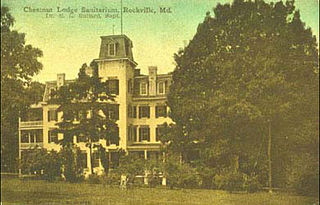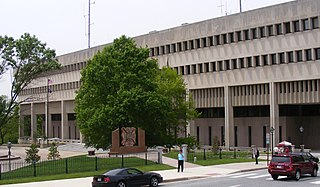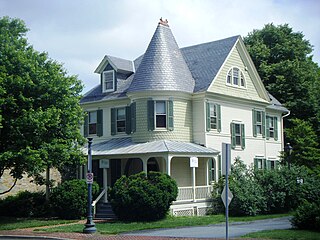
Rockville is a city in and the county seat of Montgomery County, Maryland, United States, and is part of the Baltimore–Washington metropolitan area. The 2020 census tabulated Rockville's population at 67,117, making it the fourth-largest incorporated city in Maryland.

Glenmont is an unincorporated community and census-designated place in Montgomery County, Maryland, United States. The United States Census Bureau had combined Glenmont with nearby Wheaton to create the census-designated place of Wheaton-Glenmont, from 2000 to 2010. It had a population of 16,710 in 2020.

Chestnut Lodge was a historic building in Rockville, Maryland, United States, well known as a psychiatric institution. Located at 500 W Montgomery Avenue, it was a contributing property to the West Montgomery Avenue Historic District.

Ashtabula County Courthouse Group is a registered historic district in Jefferson, Ohio, listed in the National Register in 1975.

The Cherokee National Capitol, now the Cherokee Nation Courthouse, is a historic tribal government building in Tahlequah, Oklahoma. Completed in 1869, it served as the capitol building of the Cherokee Nation from 1869 to 1907, when Oklahoma became a state. It now serves as the site of the tribal supreme court and judicial branch. It was designated a National Historic Landmark in 1961 for its role in the Nation's history.

The Baltimore City Circuit Courthouses are state judicial facilities located in downtown Baltimore, Maryland. They face each other in the 100 block of North Calvert Street, between East Lexington Street on the north and East Fayette Street on the south across from the Battle Monument Square (1815-1822), which held the original site of the first colonial era courthouse for Baltimore County and Town, after moving the Baltimore County seat in 1767 to the burgeoning port town on the Patapsco River established in 1729-1730.

The Baltimore County Courthouses are located in Towson, Maryland, the county seat of Baltimore County, Maryland. The older, original Baltimore County Courthouse was built between 1854 and 1856. It has had three additions that eventually formed an 'H' shape. It houses many of the offices of the county government, including the executive branch, county executive, and their departments, agencies, boards, commissions, and other bodies, and the county council.

Seton Hill Historic District is a historic district in Baltimore, Maryland. It was listed on the National Register of Historic Places in 1975.

The Beall–Dawson House is a historic home located at Rockville, Montgomery County, Maryland, United States. It is a 2+1⁄2-story Federal house, three bays wide by two deep, constructed of Flemish bond brick on the front facade and common bond elsewhere. Outbuildings on the property include an original brick dairy house and a mid-19th century one-room Gothic Revival frame doctor's office which was moved to the site for use as a museum. The house was constructed in 1815.

Silver Spring station is a former train station on the Metropolitan Subdivision in Silver Spring in Montgomery County, Maryland. It was built in 1945 by the Baltimore and Ohio Railroad on the foundation of a previous station, a Victorian-style brick structure built in 1878. It served intercity trains until 1986 and commuter rail until 2000. Today, it is owned and operated as a museum by Montgomery Preservation, Inc., a non-profit organization.

The Garrett Park Historic District is a national historic district located at Garrett Park, Montgomery County, Maryland. It's a 154-acre (62 ha) residential community incorporated in 1891, along the B & O Railroad. The older community includes a number of late Victorian homes. During the 1920s, the town expanded with a set of 40,640-square-foot (3,776 m2), "Chevy" houses built by Maddux, Marshall & Co. The district also includes a set of Prairie Style homes designed and built by Alexander Richter during the 1950s.

The Third Addition to Rockville and Old St. Mary's Church and Cemetery is a historic area located in Rockville, Montgomery County, Maryland. This area combines 19th century residential scale buildings with a tree-lined narrow street, country church, weathered headstones, Victorian Gothic railroad station, and a brick cast-iron front commercial structure, to create an atmosphere that evokes the era when the station served as the gateway to Rockville. In addition to Victorian Gothic, architectural styles used in residential buildings include Queen Anne, Georgian, and Colonial Revival. The area was listed on the National Register of Historic Places in 1978.

The West Montgomery Avenue Historic District is a national historic district located at Rockville, Montgomery County, Maryland. It is a residential area with single-family homes predominating. The majority of the properties within the district date from the 1880s, with a few older homes and somewhat more from later periods. The predominant character of the district is set by the rows of Victorian houses built between 1880 and 1900 in a vernacular residential mode with Eastlake and Stick Style influences. Also included in the district are attorneys' offices; churches and parsonages; a funeral home; the former Woodlawn Hotel, later called the Chestnut Lodge Sanitarium ; and the headquarters of the Montgomery County Historical Society.

Public Safety Building, or Old Post Office, is a historic building in Cumberland, Allegany County, Maryland. It was constructed between 1902 and 1904, in the Classical Revival style. It is built of brick, rising from a monumental stone base. There is a slightly projecting pavilion with four engaged Ionic columns on the second and third floors. The building was built originally as the United States Courthouse and Post Office during the tenure of James Knox Taylor (1857-1929), who was Supervising Architect for the U.S. Treasury. It served as a courthouse of the United States District Court for the District of Maryland from 1904 to 1933. It is considered to be typical of buildings constructed during Taylor's tenure to the specifications of the Tarsney Act, which required competition in the design of federal buildings.

Washington County Courthouse is a historic courthouse building located at 95 West Washington Street in Hagerstown, Washington County, Maryland, United States. It is a two-story red brick structure with white trim and decorative work in brownstone, constructed in 1872 in the Italianate style. The building features a central tower on the front façade above the main entrance and a coursed limestone foundation from an earlier courthouse which burned. It also has a mansard roof covered with shingles. The annex was built in 1963.

The Old Appomattox Court House is a former county courthouse within the Appomattox Court House National Historical Park. In the 1800s this structure gave the surrounding village its name, Appomattox Court House. Built in 1846, the structure served as the courthouse for Appomattox County, Virginia. Confederate General Robert E. Lee surrendered his army nearby in 1865, during the closing stages of the American Civil War, but the courthouse was closed that day and was not used in the proceedings. The village where the old courthouse was located had entered a state of decline in the 1850s after being bypassed by a railroad, and when the courthouse burned down in 1892, the county government was moved to Appomattox, Virginia.

First Presbyterian Church and Manse is a historic Presbyterian church located at West Madison Street and Park Avenue in the Mount Vernon-Belvedere neighborhood of Baltimore, Maryland, United States. The church is a rectangular brick building with a central tower flanked by protruding octagonal turrets at each corner. At the north end of the church is a two-story building appearing to be a transept and sharing a common roof with the church, but is separated from the auditorium by a bearing wall. The manse is a three-story stone-faced building. The church was begun about 1854 by Norris G. Starkweather and finished by his assistant Edmund G. Lind around 1873. It is a notable example of Gothic Revival architecture and a landmark in the City of Baltimore.

The Frank M. Johnson Jr. Federal Building and United States Courthouse is a United States federal building in Montgomery, Alabama, completed in 1933 and primarily used as a courthouse of the United States District Court for the Middle District of Alabama. The building is also known as United States Post Office and Courthouse—Montgomery and listed under that name on the National Register of Historic Places. In 1992, it was renamed by the United States Congress in honor of Frank Minis Johnson, who had served as both a district court judge and a court of appeals judge. It was designated a National Historic Landmark in 2015.

The Montgomery County Courthouse is located in Red Oak, Iowa, United States. It was individually listed on the National Register of Historic Places in 1981. In 2016 it was included as a contributing property in the Red Oak Downtown Historic District. The courthouse is the third building the county has used for court functions and county administration.

The Rockville Park Historic District is a national historic district in Rockville, Montgomery County, Maryland. The neighborhood was platted in 1884 along the B&O Railroad Metropolitan Branch. It is associated with the suburban development of Rockville with the extension of the railroad in 1873 and increased middle-class home ownership in the late 19th century. Its northern boundary is Baltimore Road, which is one of Montgomery County's historic roads. Three early developers of the district include William Reading, Washington Danenhower, and Joseph Reading. It is home to a diversity of residential forms and architectural styles, including Victorian, American Foursquare, bungalow, and Minimal Traditional houses from the 1950s.






























